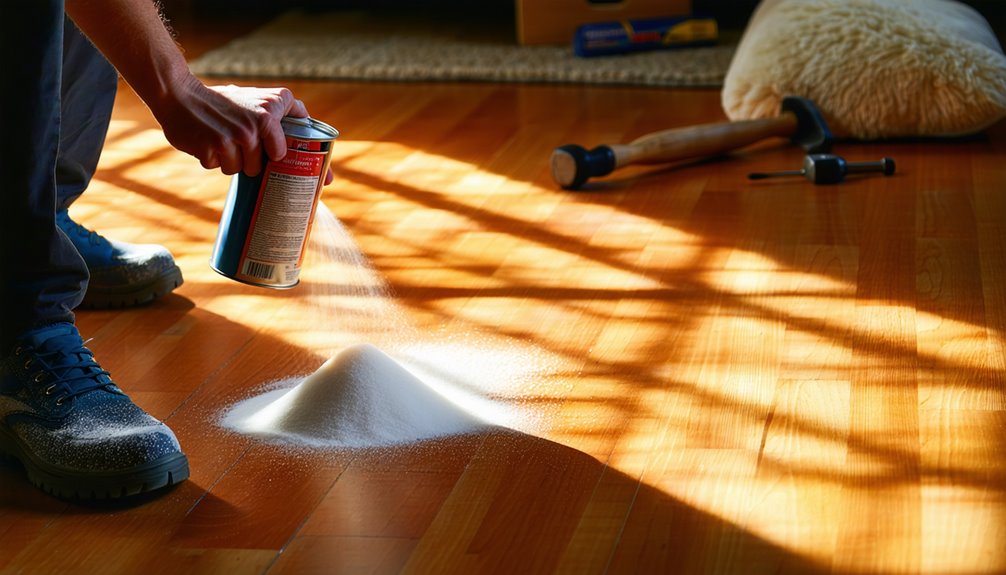To fix squeaky floors, start by identifying the problem areas. Walk around and apply gentle pressure to pinpoint noisy floorboards. Once you've marked the spots, tighten loose floorboards with a screwdriver or drill. You can also use lubricants like silicone spray or graphite powder in the gaps to reduce friction. If the squeak persists, consider using specialized squeak-reducing products or even replacing the affected floorboards. Finally, check for any structural issues that might be causing the noise. For an all-encompassing solution that addresses all aspects, you might find more helpful tips and insights as you keep going.
Common Causes of Squeaky Floors
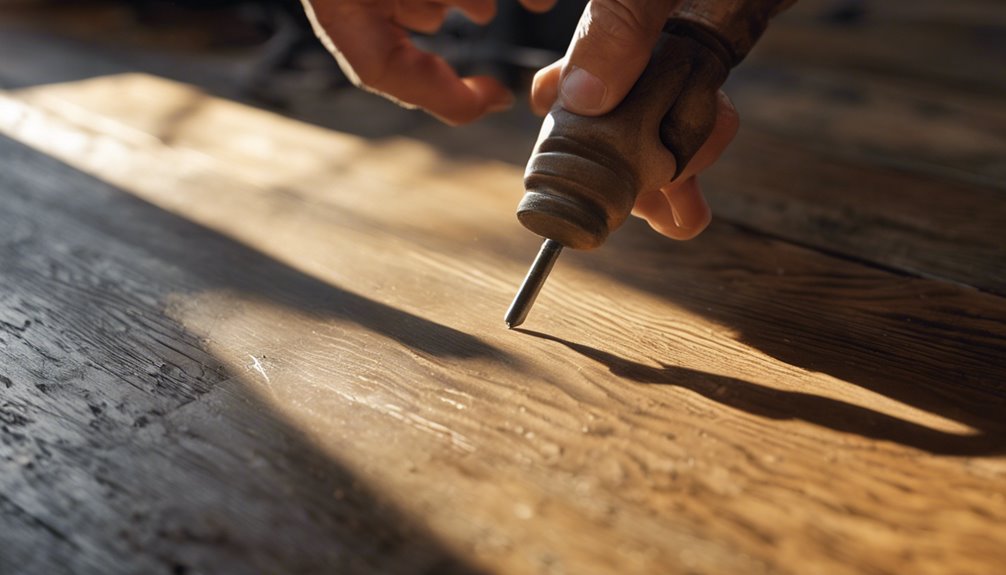
If you've ever walked across your floor and heard a bothersome squeak, you might be wondering what causes it. Squeaky floors can stem from various factors, primarily related to the floor material types. For instance, hardwood floors may squeak due to loose boards or inadequate support beneath them. On the other hand, carpeted floors may produce noise if the padding shifts or if the carpet isn't properly tacked down. Additionally, subfloor movement can lead to friction between different layers, causing those annoying sounds. Changes in humidity and temperature can also impact wood expansion and contraction, further contributing to squeaking. Understanding these causes of squeaking can empower you to take the right steps toward a quieter, more comfortable home.
Identify the Problem Area
To tackle squeaky floors effectively, the first step is pinpointing the exact problem area. Start with a thorough floor inspection; walk around the room and listen carefully for any creaking or squeaking sounds. Pay attention to high-traffic areas, as they often bear the brunt of wear and tear. Conduct a noise assessment by applying gentle pressure to the floorboards while listening closely for changes in sound. You might find that some areas are noisier than others, indicating where the issue lies. It's essential to identify these hotspots before you proceed with repairs. By knowing precisely where the problem is, you'll save time and effort, allowing you to enjoy the freedom of a quieter home soon.
Tighten Loose Floorboards
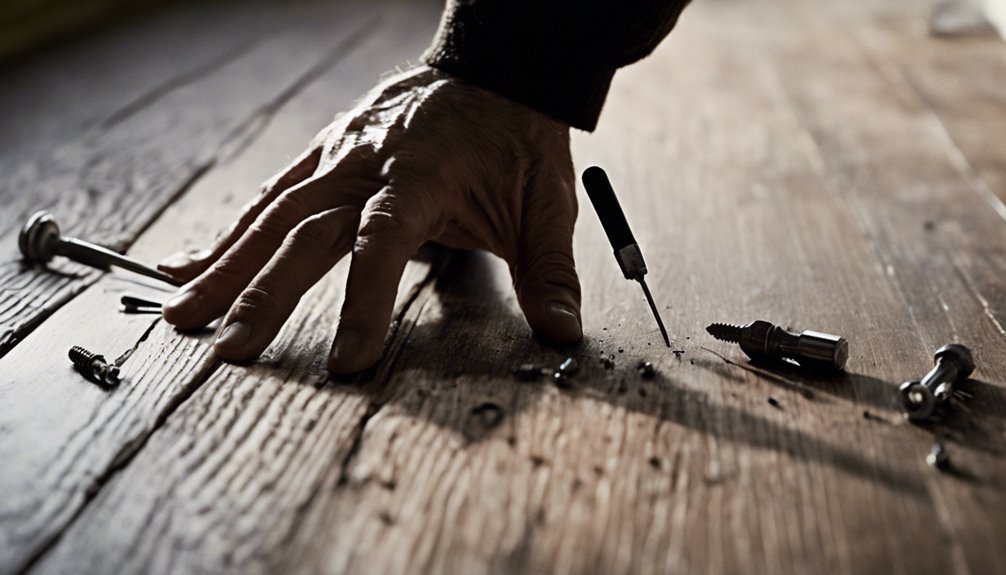
One of the most effective ways to eliminate squeaks in your floors is by tightening loose floorboards. Start by identifying which floorboard types are causing the noise. With a simple screwdriver or drill, you can secure them back into place. Make certain you check for any nails or screws that may have loosened over time. For wood floorboards, counter-sink screws slightly beneath the surface and fill the holes with wood filler for a clean finish. This not only aids in squeak prevention but also enhances the overall look of your flooring. If you're dealing with carpeted floors, make certain the underlayment is tight and secure. Tightening these boards gives you the freedom to move around your home without the annoying creaks!
Apply Lubricants
While tightening loose floorboards is a great start, applying lubricants can further reduce those pesky squeaks. For effective floor maintenance, consider using lubrication techniques that target the gaps between the floorboards and their support structures. Common options include silicone spray or graphite powder, which both create a slick barrier that minimizes friction. Simply spray or sprinkle the lubricant in the affected areas, then walk on the floor to distribute it evenly. Don't forget to wipe away any excess to prevent slippage. Regularly incorporating these lubrication techniques into your floor maintenance routine will help keep your floors quiet and free from annoying noises. Embrace the freedom of a peaceful home, and enjoy the tranquility that comes from squeak-free floors!
Use Squeak-Reducing Products
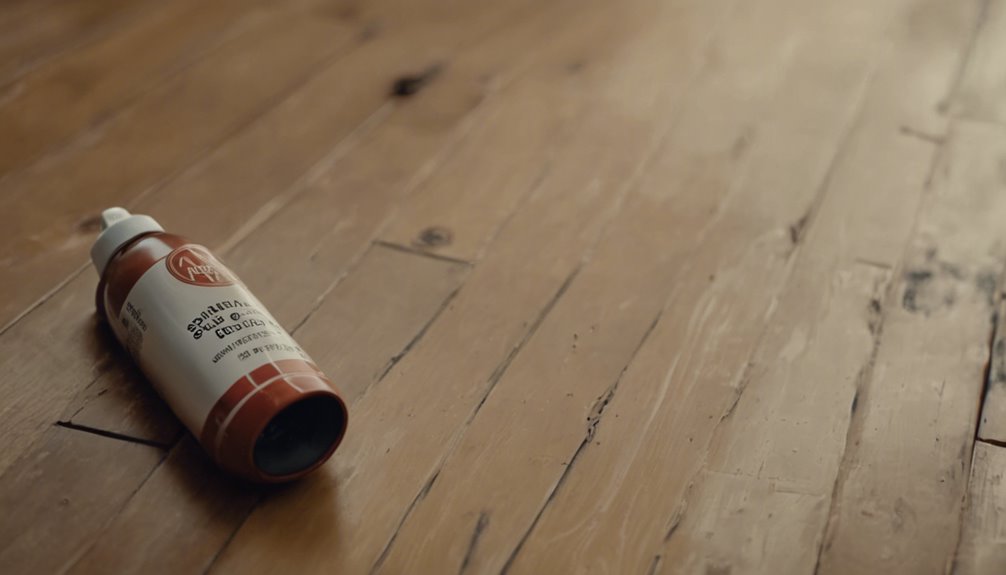
After applying lubricants to address squeaks, exploring specialized squeak-reducing products can take your floor maintenance to the next level. Squeak reducing sprays are specifically designed to penetrate gaps between floorboards and subflooring, effectively minimizing noise. Just spray it directly into the affected areas, and you'll notice a significant difference.
Additionally, consider investing in floor support systems. These systems can help stabilize your floors, reducing movement that often leads to those annoying squeaks. By combining squeak-reducing sprays with proper support, you'll enjoy a quieter and more comfortable living space. Embrace the freedom of movement in your home without the constant distraction of squeaky floors. Your feet—and your sanity—will thank you!
Install Shims
To tackle those pesky squeaks, start by identifying the problem areas between your floorboards. Once you've pinpointed where the noise is coming from, choose the right shims to fill those gaps and stabilize the floor. Finally, secure the shims with adhesive to guarantee a long-lasting fix.
Identify Problem Areas
Have you ever wondered where those pesky squeaks in your floors are coming from? Identifying problem areas is essential for effective noise reduction. Start by walking around your home while paying close attention to the spots that squeak. Squeaky floorboards often indicate loose or uneven subflooring. If you're not sure, try to pinpoint the exact location by gently pressing down on different areas. Listen for the sounds—if it squeaks when you step on it, that's a potential problem zone. Mark these areas for further inspection. Once you've identified the squeaky spots, you can move on to solutions that will restore peace to your living space. Remember, tackling squeaks gives you the freedom to enjoy your home without distractions!
Choose Appropriate Shims
When it comes to fixing squeaky floors, choosing the right shims is essential for a successful repair. You'll want to reflect on various shim materials like wood, plastic, or metal, each with its own benefits. Wood shims are great for their natural look and ease of installation, while plastic and metal shims offer durability and moisture resistance.
When you're ready for shim installation, identify the areas where the floorboards are loose. Slide the shims into the gaps between the joists and the floorboards, gently lifting them to eliminate movement. Make sure to use enough shims to provide stability, but don't overdo it, as that could create new issues. With the right shims, you'll be on your way to quiet, solid floors!
Secure With Adhesive
As you install shims to secure your floorboards, using adhesive can greatly enhance the stability of your repair. Different adhesive types work best depending on your specific floor needs. Consider options like wood glue for a strong bond or construction adhesive for a more durable hold.
| Adhesive Type | Best Application Method |
|---|---|
| Wood Glue | Apply directly to shim edges |
| Construction Adhesive | Use a caulking gun for even distribution |
| PVA Glue | Brush on for smooth coverage |
| Epoxy | Mix and apply to fill gaps |
Choose the right adhesive and method, and you'll achieve a long-lasting fix. Enjoy the freedom of a squeak-free home!
Floorboard Replacement Options
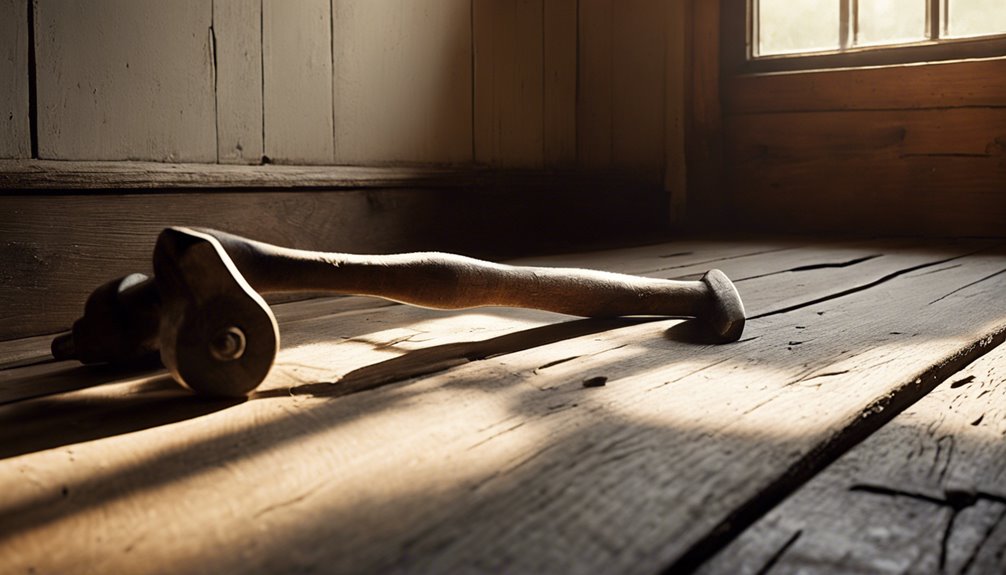
If you're dealing with squeaky floors, replacing floorboards might be your best bet to restore peace and quiet. There are several floorboard materials to evaluate, each with varying replacement costs:
- Plywood: Affordable and easy to work with. Great for a quick fix.
- Solid Wood: Offers durability and can be refinished, but it's pricier.
- Engineered Wood: Combines stability and aesthetics, usually falling in the mid-range price bracket.
Before diving into replacement, weigh your options based on your budget and the look you want. Remember, investing in quality materials can save you from future squeaks and additional costs down the line. It's all about finding the right balance between cost and long-lasting comfort.
Check for Structural Issues
Before you tackle those squeaky floors, it's essential to check for any structural issues that could be at play. Start by inspecting the joists and beams for any signs of damage, and assess the stability of your foundation. Don't forget to look for rot, as it can lead to bigger problems down the line.
Inspect Joists and Beams
When addressing squeaky floors, it's essential to inspect joists and beams, since these structural components play an important role in the stability of your flooring. A thorough joist inspection can reveal issues that may be causing those annoying sounds. Here are three key things to look for:
- Cracks or Splits: Check for visible damage that could compromise beam stability.
- Loose Connections: Make sure joists are securely attached to beams; any movement can lead to squeaks.
- Moisture Damage: Look for signs of rot or water damage that could weaken both joists and beams.
Assess Foundation Stability
To guarantee your home's floors remain stable and quiet, evaluating the foundation's stability is essential. Start with a thorough foundation inspection to identify any cracks, unevenness, or signs of settling. Check for gaps between the foundation and walls, as these could indicate potential problems. A stability assessment will help you understand if your foundation can support the weight of your home and any additional renovations you might consider. If you find issues, addressing them early can save you time and money later. Don't hesitate to consult a professional if you're unsure; understanding your foundation's health is key to maintaining the integrity of your floors and overall home. Freedom from squeaky floors starts with a solid foundation!
Check for Rot Damage
Inspecting your floors for rot damage is essential for maintaining their integrity and preventing further structural issues. A proper rot inspection can save you time and money by identifying problems early. Here's how to conduct a damage assessment effectively:
- Look for discoloration: Check for dark spots or stains, which are often signs of moisture and rot.
- Tap the wood: Gently tap the floor with a hammer; if it sounds hollow, you might have rot beneath the surface.
- Check for softness: Feel the floorboards; if they're spongy or give way easily, rot could be compromising their strength.
Soundproofing Techniques
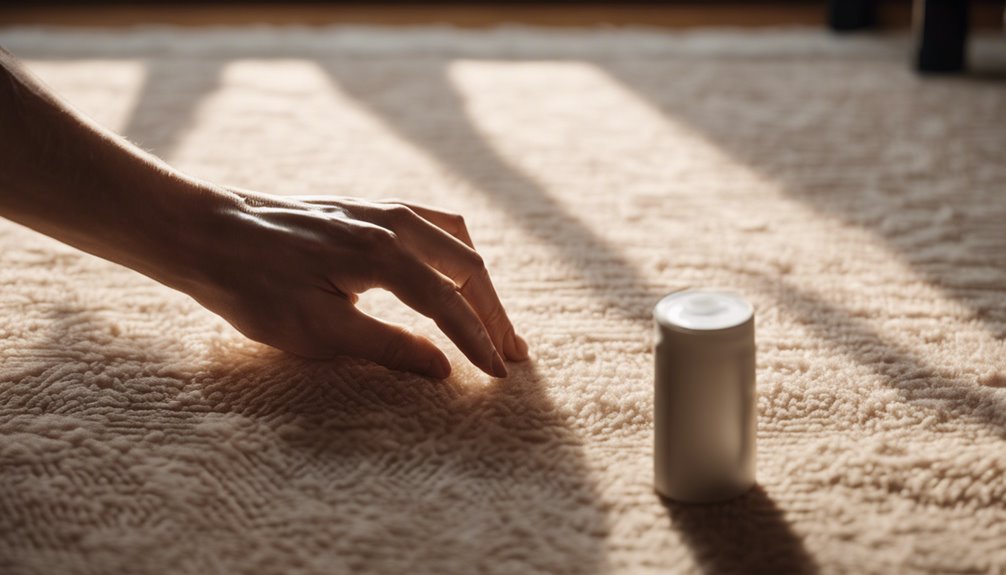
Have you ever noticed how sound travels through your home, amplifying every creak and groan of your floors? Soundproofing techniques can help you reclaim your peace. Start by using soundproofing materials like mass-loaded vinyl or foam underlayment beneath your floors. Acoustic panels on walls can absorb sound, reducing noise from footsteps. Here's a quick reference table:
| Technique | Materials Used | Benefits |
|---|---|---|
| Underlayment | Foam, rubber | Dampen sound transmission |
| Acoustic Panels | Fabric, foam | Absorb sound waves |
| Carpeting | Thick rugs | Add cushion and reduce noise |
| Sealants | Caulk, weatherstripping | Fill gaps and cracks |
Implementing these strategies will create a quieter, more enjoyable living space.
When to Call a Professional
While many minor squeaks can be fixed with a bit of DIY effort, there are times when calling a professional is the best course of action. If you're facing persistent squeaks, it's wise to seek a professional assessment. Here are three situations where you should get help:
- Structural Concerns: If you suspect floor joists are damaged, a pro can assess the situation safely.
- Widespread Issues: When multiple areas are squeaking, it might be a sign of larger repair costs that require expert attention.
- Time Constraints: If you're short on time or unsure about your skills, hiring a professional can save you headaches down the road.
Don't hesitate to reach out—sometimes, expert help is the key to a peaceful home!
Frequently Asked Questions
Can Humidity Affect Squeaky Floors?
Yes, humidity can definitely affect squeaky floors. When humidity levels rise, wood expands, which might lead to boards rubbing against each other or the subfloor. This friction often results in those annoying squeaks. Conversely, in dry conditions, wood contracts and may create gaps, which can also contribute to noise. Keeping your home's humidity balanced is key to minimizing these effects and maintaining the peace you desire in your living space.
How Can I Prevent Future Squeaks?
Imagine your home as a serene symphony, where every creak is a note in harmony. To prevent future squeaks, embrace floor maintenance tips like regularly checking for loose boards and applying lubricants to joints. Consider preventive measures such as using area rugs to reduce wear and tear. Keep humidity levels stable to protect your flooring. With these simple steps, you can guarantee your floors sing a sweet, uninterrupted melody for years to come.
Are Squeaky Floors a Sign of Damage?
Squeaky floors can be concerning, but they don't always indicate damage. Often, it's just a sign of normal wear and tear or loose floorboards. However, if the squeaks are frequent and loud, it might be worth investigating further, as it could affect the structural integrity of your home. Addressing these issues early on can help you maintain your freedom to enjoy a safe and comfortable living space without worrying about potential problems.
Will Carpets Hide Squeaky Floor Issues?
Imagine walking through a cozy, sunlit home, where every step feels like a gentle whisper. Carpets can indeed help mask squeaky floors, thanks to their thick carpet padding that offers sound absorption. However, while they may reduce the noise, they won't fix the underlying issue. If you're seeking freedom from distractions, consider addressing the squeaks directly for a peaceful environment, rather than relying solely on carpets to cover them up.
Can I Fix Squeaky Floors Myself?
Absolutely, you can fix squeaky floors yourself! With some DIY solutions, you can tackle this common issue and enhance your floor maintenance routine. Start by identifying the squeaky areas—often, it's loose floorboards. You can apply powdered graphite or sprinkle talcum powder in the gaps to reduce friction. For a more permanent fix, adding screws or shims can help stabilize the boards. It's a rewarding project that gives you control over your home's comfort!

